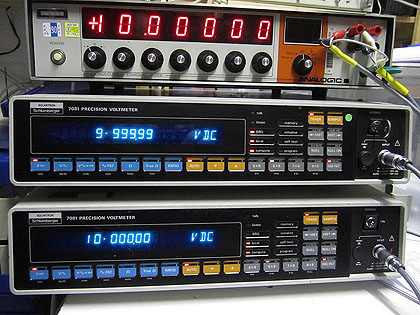

Return to home page
This page has no real purpose, other than sharing a fetish of mine, namely admiring high precision instrumentation and performing accurate measurements.
I snatched some classic ultra-precision (8 1/2 digit) DMMs from my employer's junkyard, with some minor blemishes, some with corrupted ROMs that need to be reinstated etc; actually I enjoy reparing old stuff and this is more interesting than I tought. Finally I made everything work fine.
Actually I spent several weeks on one of the Solartron 7081; it displayed thermal crashes and after hours with freeze spray and hot air gun I identified the culprits, mostly ILQ74 optocouplers. All calibrations seemed to be still fine, ie., a few ppm off as compared to my DataPrecision 8200 calibrator and Datron 1281 multimeter.


Over time I learned the subtleties how to perform accurate measurements (up to a few uV), here some examples:
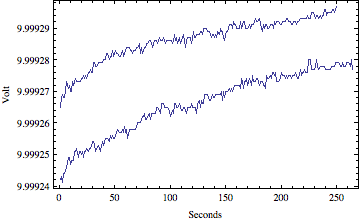

Left pic: comparison of the two Solartron 7081's for an ultra-precision 10V voltage sources VRE102CA.
Right pic: accuracy/voltage spread of a few VRE102CA's.
As for the temperature dependence of my most accurate DMMs, the Datron 1218 and the Solartron 7081, I conducted various tests and here is a typical measurement:

This simulates temperature readings by substituting thermistors by fixed standard 1% 10K resistors, which were thermally stabilized by a TEC and kept constant to a fraction of a degree. The room temperature was then changed in a controlled manner and the resistance measurements (converted to temperature readings) were logged over a long time. In this way, a temperature coefficient between 3 and 4 ppm/C of the meters was determined. This required 7 digits resolution. As for the HP3478A, the resolution at 5 1/2 digits was not sufficient in order to see any effect.
Actually having a temperature controlled room environment is quite handy for various reasons; in particular, my measuring setups tended to de-adjust overnight during long-tern measurements like spectrum scans. Also for holography sessions a fairly constant room temperature is a necessity. I found that little process controllers such as the D1S-VR together with a solid state relay and a portable 2000W room heater are great to keep the room temperature constant to like 0.1-0.2 degrees without problem.
There was some debate in de.sci.electronics about the accuracy of cheap 4- and more digits panel meters from China. Somehow I had missed that these devices are readily available from ebay, and they are handy because the usualy limit at 1999 digits of usual 3 1/2 digit panel meters is often very inconvenient (eg for current meters in laser diode controllers exceeding 200mA). So I ordered a HB8140A from Virtual Village and conducted a few tests with my DataPrecision 8200 calibrator. All-in-all it is not too bad: initial accuracy was 0.16% off, linearity is good, but the last digit does not always faithfully follows a changing voltage, sometime it lags 1-3 counts behind; there seems even a hysteresis, which means that depending on whether one approaches a given value from below or above, a slightly different reading shows. This can be seen in this little movie:
A need for high accuracy arises in the context of stability measurements of TEC controllers for my diode lasers. Here one needs to check the long-term constancy of the temperature to better than 1/1000 of a degree. The absolute temperature is not important, but as a matter of principle, I like to detemine it as well as accurate as possible. That's actually not easy, one has to fight thermally generated voltage differences across of junctions of different metals, which become relevant despite in the uV range. For Pt100 sensors this is particularly serious, here one needs to use the 4-wire "Kelvin" method to cancel such EMF and line resistance differences to less than a few milliohms. At the probe and at the meter, respectively, the metal junctions of the wiring need to be at the same temperature, etc.
The best I can do for absolute measurements is with a precision thermometer PN5207 which by itself is accurate to 0.02 degrees, apart from the "Class B/3" Pt100 sensors which are accurate up to 0.1 degrees in absolute terms. They can be used to calibrate the standard surplus 10k NTC thermistors that I use in my projects:
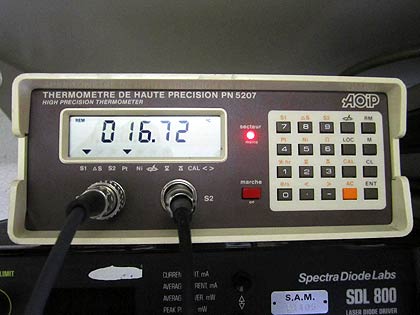
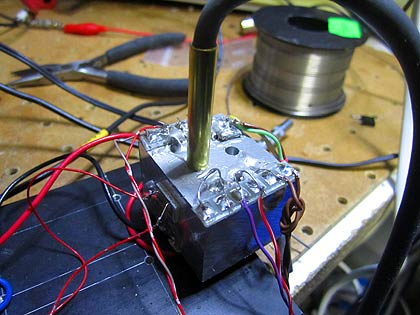
Pic to the right shows a TEC controlled aluminum block with the thermistors embedded.
Interestingly the cheap thermistors are not at all bad and their absolute accuracy is also of the same order of magnitude as the Pt100 sensors, ie., 0.1 degrees:
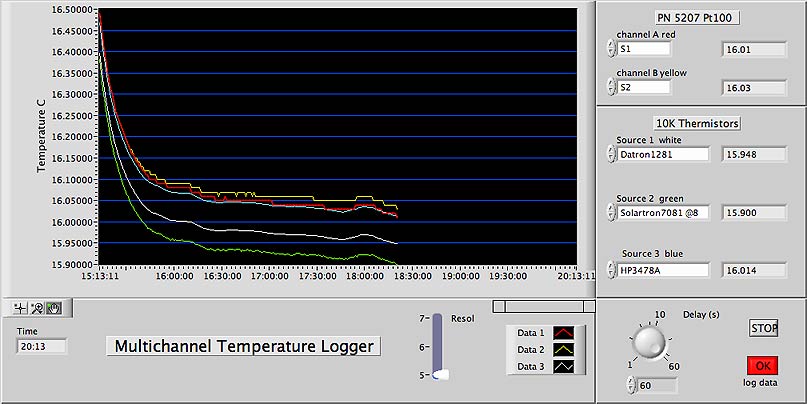
Red and yellow traces: Pt100 sensors, white, green and blue: 10K Thermistors.
red: Pt100 Class B/3 Heraeus M1020 (+/- 0.1C)
yellow: Pt100 Class A Heraeus M422 (+/- 0.15C)
white: Epcos 10K thermistor S867
green, blue: noname chinese 10k thermistors from ebay
We see that the two platinum sensors typically differ by 0.01-0.02 degrees, which gives confidence in the claimed accuracy.
Not shown: encapsulated "Class A" no-name chinese Pt100 sensor from ebay shows 0.3C less temperature which is beyond what Class A would allow for!
Return to home page
Vers. 1.0 -12/11